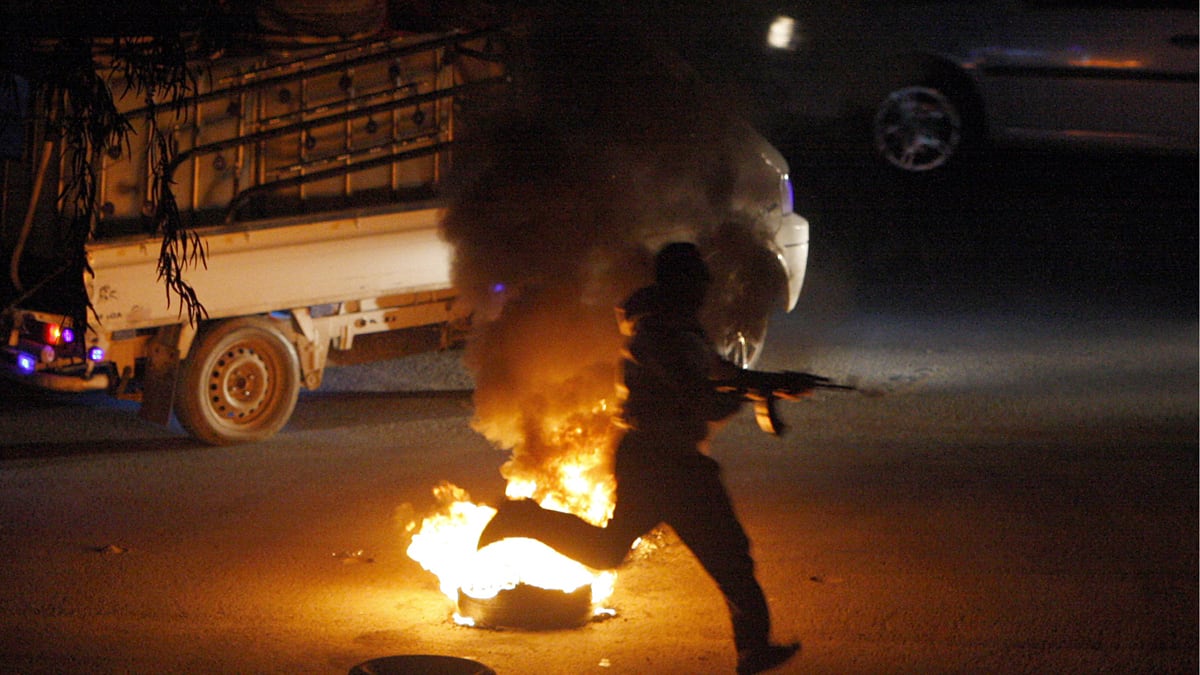It’s through people like Omar Tellawi that scenes of the bloodshed in Syria have reached the rest of the world.
Tellawi is part of a small, tightly knit group of Syrian video activists who have embedded themselves inside Homs, the center of a brutal crackdown by Bashar al-Assad’s regime. Foreign journalists are barred from the city—and if they manage to sneak in, they can become targets, as happened when photographer Rémi Ochlik and legendary war correspondent Marie Colvin were killed recently.
Tellawi and his fellow activists document the regime’s atrocities with low-tech video dispatches, often reporting via Anderson Cooper–like stand-up reports. They post their work on YouTube, and it spreads globally via social media and the international press. Some of the so-called vee-jays—such as 23-year-old Danny Abdul Dayem, whom the Western press has dubbed the “voice of Homs”— feature regularly on networks such as Al-Jazeera and CNN and have become unlikely media stars in the course of the conflict.
A new report, airing tonight on Britain’s Channel 4 News, shows the video activists in a new and intimate light. In it, Tellawi and his colleagues scramble to confirm death tolls, brave bomb blasts, and duck sniper fire.
They also, it turns out, embellish.
Channel 4 News gave The Daily Beast an exclusive look at the upcoming documentary, shot by an up-and-coming photojournalist named Mani, who goes by only one name, in order to avoid compromising future trips to Syria.
Over the course of several weeks in January and February, Mani embedded himself with Tellawi and his colleagues to witness some of the toughest days of Syria’s ongoing conflict. Mani, 40, hails from France but once studied in Damascus and is fluent in Arabic. A primary-school teacher less than two years ago, he left his job to pursue a passion for photography and gained worldwide attention with his inaugural video report last month, a gripping account of the fighting in Homs. Nevine Mabro, Mani’s editor at Channel 4, called it “the best combat footage I’ve ever seen in 12 years of looking at this stuff.”
In his newest video for Channel 4 News, Mani turned his focus to the video activists whose reports have defined international perception of the longest-running uprising of the Arab Spring. The young vee-jays report as their camera rattles from a nearby explosion. They produce a harried stand-up segment in front of the Baba Amr media center, where Colvin and Ochlik later died. They press on even after colleagues are maimed or killed in action. One scene shows a wounded activist who has just been shot through the chin and neck; Mani reports that the young man survived and was back out on the street, shooting film, in a matter of days. The activists scramble to confirm death tolls and duck sniper fire.
The report also spotlights how activists, in one instance, stage a video. In one scene, Mani catches Tellawi complaining to his colleagues that the section of Homs they’re reporting from is too far from the action. “We’ll need to set a tire on fire,” Tellawi says, in order to mimic smoke from battle. Then, Tellawi remembers that he’s being filmed and turns to Mani’s camera with a sheepish grin. Later in the day, Tellawi stands on a rooftop to record a video dispatch as smoke billows behind him. It’s a visually harrowing scene. Mani pans past Tellawi and traces the smoke to an alley below, where a tire is engulfed in flames.
“He was embellishing,” Mani said, during an interview last week. “They’re trying desperately to show what is happening. It’s complicated for them.”
Assad’s regime has worked hard to discredit activists since the revolution’s start—and thus are likely to jump on any suggestion of embellishment, no matter how minor, as evidence of full-scale fabrication of the atrocities.
Shortly after the protests began, one prominent Syrian cyberactivist, then going by the handle Malath Aumran, told The Daily Beast that phony Twitter activists—whom he suspected of being affiliated with the regime—had been tweeting links to videos of massacres that later proved to be fakes, in hopes of hurting the reputations of the real activists who passed them along. With video activists playing an increasingly important role as the conflict becomes more violent, and independent journalism harder to carry out, the regime has tried to cast doubt on their reporting.
These efforts can border on the absurd. As Robert Mackey wrote recently in an extensive report on Lede blog at The New York Times, “The Syrian government continues to dispute the authenticity of the footage, day after day, and works to undermine the credibility of activists and reporters it accuses of either fabricating the images or lying about what they show.” In one instance, Mackey points out, a fake Twitter account launched in the name of Dayem, the 23-year-old activist, tried to discredit him with tweets from the supposed Dayem that depicted him as someone who “was out to foment sectarian discord and was trying to arrange armed intervention by Israel—by asking Mia Farrow to ask Woody Allen.”
While the brutality of Assad’s crackdown is clear—and few, if any, seasoned observers buy into the regime’s anti-activist smear campaigns—Tellawi’s burning tire spotlights an issue journalists who rely on footage from video activists have struggled with from the start: How much can they trust footage they’re getting from sources who are clearly partial to the opposition’s cause?
Anderson Cooper recently dedicated a long CNN segment to debunking allegations that Dayem was embellishing his reports. As Mabro, the deputy foreign editor at Channel 4 News, puts it: “News organizations have been relying on these guys for footage for the last six months, but they’re not journalists. They have a message they want out.”
Danny O’Brien, the Internet Advocacy coordinator at the Committee to Protect Journalists, cautions that video activists should be treated with the same skepticism as any source, especially as the conflict drags on and the battle for information heats up. “I don’t think there is any difference between someone giving you a video and saying, ‘hey, this is what is really happening’ and someone telling you, ‘hey, this is what is really happening,’” he says. “Just as you’ve seen an escalation in the violence, you’ve seen an escalation in the propaganda—from all sides.”
Assad’s effective propaganda machine—and the regime’s ability to keep most international journalists out of Homs and other cities—has raised the stakes for the video activists.
Jillian York, the director for International Freedom of Expression at the Electronic Frontier Foundation, has been tracking social media activism closely throughout the Arab Spring. She says that in the information battle, Syria’s activists have had a much tougher fight than their counterparts in countries such as Egypt or Tunisia, who managed to make relatively short work out of ousting their respective dictators. “There’s no question that video is more important there,” she says. “Syrian opposition activists are up against a whole lot more than Tunisians and Egyptians were, not just in terms of violence, but also with the pro-regime narrative.”
Mani lived with the video activists during much of his recent Homs trip and says the tire incident was the only example of embellishment he saw. The greater problem, he says, is that the video activists are selective in what they show. With the Assad regime dead-set on portraying the revolution as the work of what it calls armed “terrorists,” Mani says, the activists were reluctant to show members of the Free Syrian Army that is leading the armed aspect of the opposition’s fight—and they were touchy about having him shoot them as well, though he eventually succeeded in doing so.
The activists also don’t want to mention any signs of sectarian tension.
Mani eventually succeeded in persuading the activists that they had nothing to lose from letting him portray their struggle in all its shades. “I’m not saying what they upload is not real. It is. But they are selective,” Mani says. “There is no nuance. But I think it’s difficult for them to be nuanced.”
Alison Langley, an adjunct professor of journalism at Webster University based in Austria, spent months monitoring the Homs video activists for a report that will be published this spring. She points out that the tactics they employ—demonizing their opponent, and sticking to an internationally minded message—is a common one in conflicts. In her report, “Verifying Sources,” Homs vee-jay Omar Shakir admits that he and his colleagues focus as much on the horrors of the crackdown, and as little on the armed opposition, as they can. “Sometimes you have to be clever with journalists,” Shakir tells her.
“I set the tire on fire because there was a violent shelling on Baba Amr district and we couldn’t reach it,” Tellawi responded by email, when contacted by Mani on behalf of The Daily Beast. “We are being killed with cold blood by the occupying Assad regime. This is the idea that came to my mind to show the world about the shelling as the sky of Homs was covered with smoke.”
“They are desperate to get the word out,” Mani added. “But they don’t need to embellish. It’s all around.”
After Tellawi finished his report, with the tire smoke still billowing, Mani kept filming. With Tellawi still standing on the rooftop, Mani’s camera shook from a deafening blast, as a shell exploded nearby.

